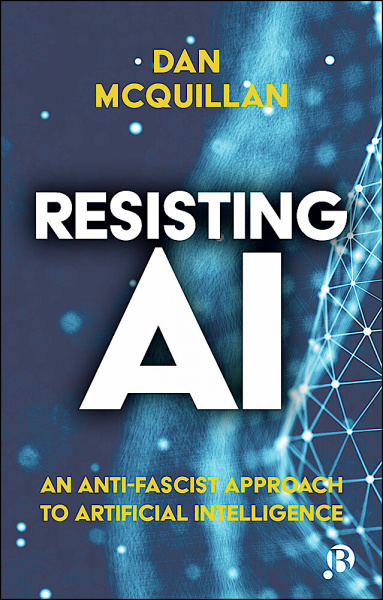Resisting AI - chapter abstracts
Chapter abstracts for 'Resisting AI - An Anti-fascist Approach to Artificial Intelligence'
Available for pre-order from Bristol University Press
chapter 0 - introduction
The introduction starts by grounding AI, for the purposes of the book, as the computational methods of deep learning and the associated institutions and ideologies. It sets out the reasons for resisting AI that are covered in Chapters 1 to 4, introduces the idea of an anti-fascist approach to AI, andd closes by outlining the path to overcoming existing AI that is taken in Chapters 5 to 7.
chapter 1 - operations of AI
This chapter delves into the actual mechanics of machine learning. It emphasises the algorithmic operations of optimisation as well as the dependencies on data. Moving on to neural networks it examines the internal transformations of the data, for example through backpropagation, and the paradoxical pairing of predictive accuracy with opacity. The chapter highlights the materiality of AI and its consequences in terms of both carbon emissions and the centralisation of control. It closes by focusing on the poorly paid and invisible workforce that underpins AI, and the continuous thread of anti-workerism that connects the origins of computing (Babbage) to contemporary applications of AI (Amazon).
chapter 2 - collateral damage
This chapter looks at the surprising brittleness of AI and the way its reliance on proxies and shortcuts haunts its social application. It critiques the post-hoc attempts to 'fix' AI's damaging effects through ethics, regulation or human intervention, and focuses on the way AI not only produces discrimination but intensifies existing structural injustice. The chapter closes by looking at the way the performative character of AI produces the very subjects of its judgements, and at the inherently backward-looking nature of its solutionism. The result is deemed to be recipe for 'AI Realism'.
chapter 3 - ai violence
Chapter 3 looks at the entanglement of AI with systemic social structures. It starts with the way AI poaches its legitimacy from science. This authority acts as cover for AI's role in increasing neoliberal precarity and austerity, spreading the social logic of financialisation into everyday life. The chapter examines AI's enrolment by institutions of the state, especially welfare systems, and the way it amplifies thoughtlessness and administrative violence. It closes with AI's operation as a technology of racialisation, its similarities to genetic determinism, and the way it becomes a candidate mechanism for a modern race science.
chapter 4 - necropolitics
This chapter looks at the impacts of AI under conditions of social crisis. It describes the way AI acts as an algorithmic shock doctrine, becoming an apparatus for producing states of exception. The effects of the COVID-19 pandemic prefigure the algorithmic distribution of life chances, where AI acts as a necropolitical technology. The chapter explores the origins of AI’s mathematical optimizations in the history of eugenics, and its legacy in the search for superior intelligence. It identifies the steps by which AI may become, through ultrarationalism and neoreaction, a part of a fascistic politics. Chapter 4 closes by looking at AI’s potential enrolment in fascistic responses to the climate crisis.
chapter 5 - postmachinic
Chapter 5 sets out a standpoint for resisting AI based on mutuality and care. It draws from feminist and post-normal science as a way to challenge exclusionary claims to authoritative knowledge. The chapter applies feminist new materialism to interrupt AI's configuration of reality, and to counter its operations of separation with a perspective that is fundamentally relational. This establishes a form of critical pedagogy which can be used to 'learn against the machine' and to recover the potential of prefigurative politics, of 'the possible against the probable'. Ultimately, the chapter recomposes the question of AI as a matter of care that directs attention to the effects of boundaries and exclusions and to the neglect of our interdependence.
chapter 6 - people's councils
Chapter 6 takes the ethics of Chapter 5 and turns them into political tactics through the principles of mutual aid and solidarity. Algorithmic boundaries and enclosures are challenged by a commitment to commonality. The struggles of workers 'above' and 'below' the algorithm are put in relation to the potential of the workers' council, a directly democratic form of organising that is a starting point for structural renewal. This is extended to the idea of the people's council as a self-constituting struggle against abstract segregation. Resistance to AI is compared to the historical movement of Luddism and the need for community constraint of harmful technology. The overall approach is anti-fascist, in that it is both an early recognition of the intensity of the threat and a defence of the space for emancipation.
chapter 7 - anti-fascist AI
Chapter 7 lays out the way an anti-fascist approach to AI moves from resistance to restructuring. It shows by example why an anti-fascist approach must be both decolonial and feminist. The anti-fascist goal of structural renewal is discussed in terms of socially useful production, solidarity economies and the centrality of commons, such that optimization is replaced by commonization. Chapter 7 closes by outlining a new apparatus, one that resonates with a renewed vision of the social. While it may or may not use advanced computation, a new apparatus will support a transition to social autonomy. In place of AI as we know it, the recursive horizontality of a new apparatus is open and adaptive. Rather than trying to 'solve' anything, it helps to sustain care under radically changing conditions.
more ...